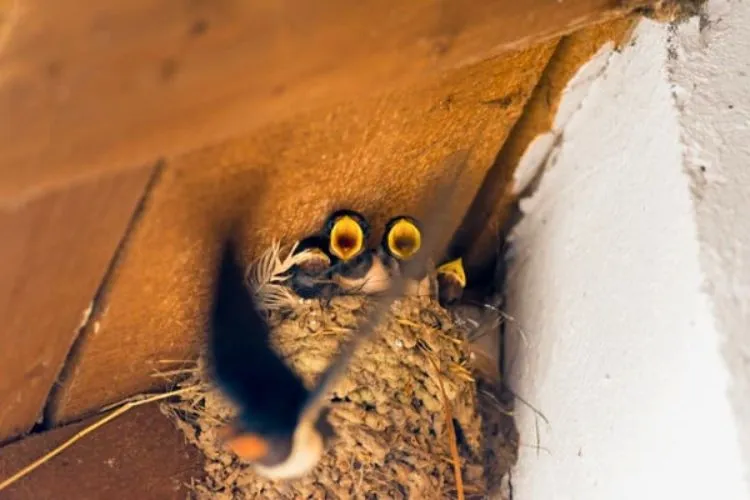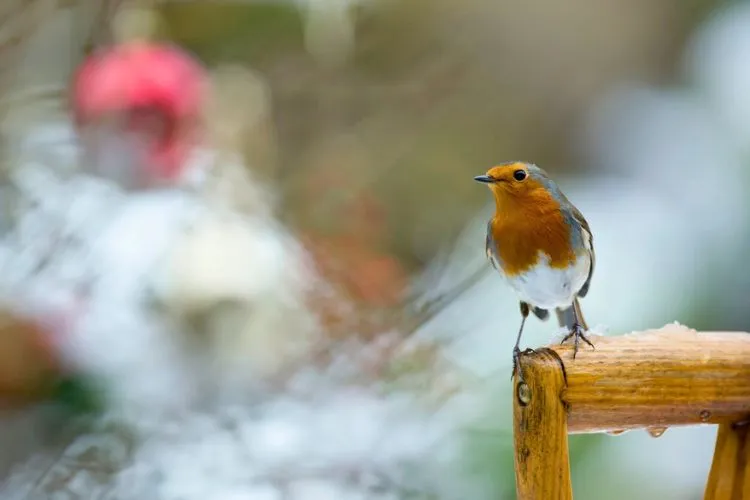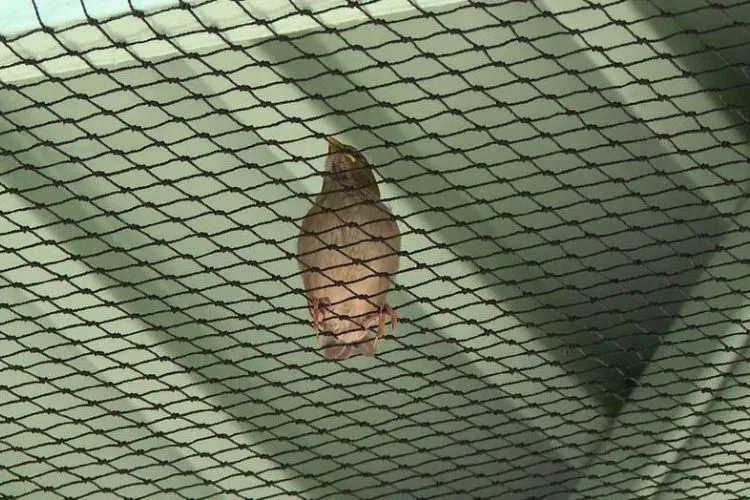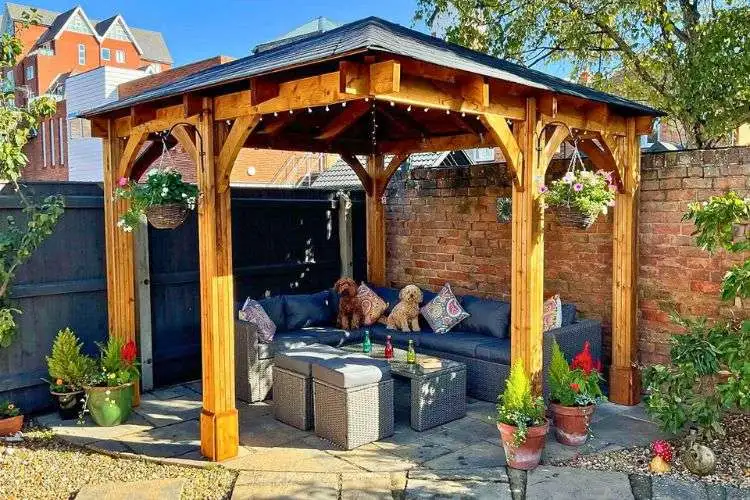Gazebos serve as serene retreats in the heart of our gardens, offering a shaded spot for relaxation and gatherings.
However, the frequent visits by birds can turn this peaceful haven into a less appealing space.
Birds may bring noise, droppings, and damage with them. This article explores effective strategies to keep birds out of your gazebo, ensuring it remains a clean and peaceful space.

Contents
- 1 Understanding Bird Behavior
- 2 How to Keep Birds Out of Your Gazebo?
- 3 Physical Deterrents
- 4 Natural Deterrents
- 5 Maintenance and Monitoring
- 6 Ethical Considerations
- 7 Introduction to Humane Bird Deterrence
- 8 Pro Tips
- 9 Frequently Asked Questions (FAQs)
- 9.1 What are safe and humane ways to keep birds away from my gazebo?
- 9.2 Can bird netting be aesthetically pleasing while being functional?
- 9.3 How often should I change or move bird deterrents around my gazebo?
- 9.4 Is it possible to discourage birds without harming the surrounding environment?
- 9.5 What should I do if a bird has already nested in my gazebo?
Understanding Bird Behavior
Why Birds Are Attracted to Gazebos?
Birds seek out gazebos for several reasons. They offer shelter from predators, making them safe spots for resting.
The structure of a gazebo provides the perfect nesting site with its beams and rafters. Access to food sources around gazebos, from open trash bins to pet food, also attracts birds.

Lastly, the high points of a gazebo offer an excellent vantage point for birds to perch and survey their surroundings.
The Impact of Birds on Your Gazebo
While birds are part of the natural charm of outdoor spaces, their presence in a gazebo can have downsides.
Bird droppings are not only unsightly but can also be corrosive, damaging the gazebo’s structure over time.
Nesting materials scattered around can contribute to a mess. The noise, while pleasant in nature settings, can become a constant background nuisance especially in early mornings.
How to Keep Birds Out of Your Gazebo?
Regular Cleaning
Maintaining a clean gazebo environment reduces the attraction for birds. Food remnants from picnics or gatherings should be cleaned up promptly to not entice birds.
Restricting Access to Food Sources
Ensure trash bins near the gazebo are securely covered. Avoid feeding pets outside or if you must, ensure no food remains afterwards. Consider bird-proof feeders that prevent spillage, reducing food availability for unwelcome birds.
Physical Deterrents
Bird Netting
Installing bird netting is a physical barrier to prevent birds from entering the gazebo area. It’s essential to choose a durable material and ensure it is positioned to cover potential entry points without obstructing the aesthetics of the gazebo.

Spikes and Gel Repellents
Bird spikes can be placed on beams and ledges where birds are likely to perch. These spikes are not harmful but discourage birds from landing.
Similarly, non-toxic bird gels can deter birds from perching on treated surfaces due to their sticky texture.
Reflective Objects
Bright, reflective objects like tapes, old CDs, or specially designed reflective discs can scare birds away. The light reflections, especially when moving, can deter birds from approaching the gazebo.
Natural Deterrents
Decoys
Using decoys that resemble birds’ predators, such as owls and hawks, can be an effective deterrent when placed around the gazebo.

It’s crucial to move these decoys periodically to maintain the illusion of a live threat.
Sound Deterrents
Ultrasonic repellents produce sound waves uncomfortable for birds but are inaudible to humans.
Alternatively, wind chimes can provide a gentle sound deterrent that’s pleasant for humans but disturbing for birds.
Scents and Plants
Some plants emit scents that birds dislike. Planting these around your gazebo can create a natural deterrent.
Additionally, aromatic scents, whether from oils or specially formulated products, can further discourage birds.
Maintenance and Monitoring
Regular Inspections
Regularly inspect your gazebo for signs of nesting or attempt to build nests. Sealing off potential nesting spots and keeping the space clean and free of nesting materials is crucial.

Adjusting Strategies
Bird behavior can change, requiring adjustments in deterrence techniques. Regularly evaluate the effectiveness of your methods and be prepared to rotate or combine different deterrents for the best result.
Ethical Considerations
Addressing bird deterrence ethically involves employing humane methods that respect wildlife while safeguarding our spaces.
Instead of resorting to harmful or lethal approaches, the focus should be on non-invasive strategies that deter birds without causing them injury or distress.

For instance, using visual or auditory deterrents that simply discourage birds from the area rather than harm them. This not only protects the birds but also maintains ecological balance.
It’s imperative to research and select methods that have been proven to be effective and humane, ensuring we live in harmony with nature while protecting our environment and its inhabitants.
Introduction to Humane Bird Deterrence
The increasing intersection of human habitats with nature calls for ethical bird control measures that harmonize with environmental preservation.
As urban areas expand, birds often find themselves in conflict with human activities, leading to the need for humane bird deterrence strategies.

It’s vital to employ methods that protect bird welfare while preventing property damage or health hazards.
This balance ensures that humans can coexist peacefully with birds without disrupting their natural behaviors or habitats.
By prioritizing humane approaches, we affirm our commitment to biodiversity and sustainable living, thereby preserving not just the beauty of wildlife but also the health of our ecosystems.
Pro Tips
Combining several deterrents increases the chances of effectively keeping birds away. In persistent cases, consulting with wildlife control experts may offer specialized solutions tailored to your particular situation.
Frequently Asked Questions (FAQs)
What are safe and humane ways to keep birds away from my gazebo?
Employing a combination of methods such as reflective objects, sound deterrents, and decoys offers effective, bird-friendly solutions.
Can bird netting be aesthetically pleasing while being functional?
Yes, bird netting can be discreetly installed to blend with the gazebo’s design, offering protection without compromising aesthetics.
How often should I change or move bird deterrents around my gazebo?
Adjust or rotate deterrents every few weeks to prevent birds from becoming accustomed to them.
Is it possible to discourage birds without harming the surrounding environment?
Absolutely. Many bird deterrence methods are environmentally friendly, focusing on deterrence rather than harm.
What should I do if a bird has already nested in my gazebo?
Check local wildlife laws before acting. If the nest can be legally removed, do so carefully and place deterrents to prevent future nesting. If removal is not allowed, wait until the nesting period is over and then take preventive measures to avoid recurrence.
Conclusion:
Keeping birds out of your gazebo requires a blend of cleanliness, preventative measures, and deterrents.
By understanding why birds are attracted to your gazebo and employing effective strategies, you can enjoy your outdoor space without the nuisances associated with our feathered friends.

Sergio Gomes, a passionate advocate for outdoor living and the male voice behind Shades Authority. With years of experience, Sergio is your trusted source for expert insights on gazebos, pavilions, cabanas, pergolas, and all things outdoor shade solutions. Join him on a journey to transform your outdoor spaces into stunning, functional retreats
